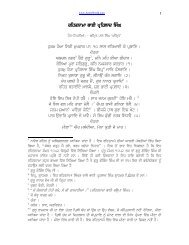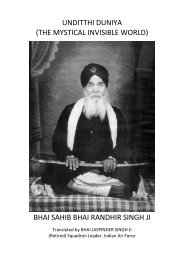Guru Gobind Singh's Death at Nanded Examination of - Vidhia.com
Guru Gobind Singh's Death at Nanded Examination of - Vidhia.com
Guru Gobind Singh's Death at Nanded Examination of - Vidhia.com
You also want an ePaper? Increase the reach of your titles
YUMPU automatically turns print PDFs into web optimized ePapers that Google loves.
30 AN EXAMINATION OF SUCCESSION THEORIES<br />
in the rose and Ganga w<strong>at</strong>er. [X, 653, Appendix VI.]<br />
Kesar Singh makes no mention <strong>of</strong> any heavenly recep^<br />
tion or anything else <strong>of</strong> the kind.<br />
In the fourteenth chapter, the author reaffirms th<strong>at</strong><br />
<strong>Guru</strong> <strong>Gobind</strong> Singh had formally proclaimed and installed<br />
Granth Sahib on the gaddi <strong>of</strong> <strong>Guru</strong>ship and th<strong>at</strong> no one else<br />
was to be recognized as <strong>Guru</strong> (verses 220-21). He also says<br />
th<strong>at</strong> "<strong>at</strong> present Granth Sjhib is our <strong>Guru</strong>," and "without the<br />
Granth, accept no one else as <strong>Guru</strong>". [Verses 300, 307; also<br />
see 297, Appendix VI.]<br />
Bhai Sukha Singh, the author <strong>of</strong> the Gur-bilds, <strong>com</strong>pleted<br />
in 1854 Bikrami, 1797 A.D., is more <strong>of</strong> a poet than a<br />
narr<strong>at</strong>or <strong>of</strong> events in any chronological or historical order.<br />
According to him, Emperor Bahadur Shah moved away from<br />
<strong>Nanded</strong> soon after the arrival <strong>of</strong> the <strong>Guru</strong> there, while the<br />
l<strong>at</strong>ter stayed on <strong>at</strong> <strong>Nanded</strong>. But actually the Emperor stayed<br />
there for some six weeks and crossed the river Godavri to<br />
the south on October 7, 1708, soon after the de<strong>at</strong>h <strong>of</strong> the<br />
<strong>Guru</strong>. He was present <strong>at</strong> <strong>Nanded</strong> on the left bank <strong>of</strong> the<br />
river throughout the last days <strong>of</strong> the <strong>Guru</strong>. He was there<br />
when, according to the Amar Namah, the Hindus <strong>of</strong> <strong>Nanded</strong><br />
<strong>com</strong>plained to him on September 3, 1708, against the Sikhs<br />
having killed go<strong>at</strong>s and cooked me<strong>at</strong> on the sacred day <strong>of</strong><br />
sun-eclipse. It was on th<strong>at</strong> day th<strong>at</strong> the <strong>Guru</strong> had visited the<br />
hermitage <strong>of</strong> Bairagi Madho Das and had baptized him as<br />
Banda Singh, who became the first liber<strong>at</strong>or <strong>of</strong> the Panjab<br />
from under the Mughal yoke. The Emperor was still <strong>at</strong><br />
<strong>Nanded</strong> when he sent his own surgeon, a European (Ferrangi),<br />
Call or Cole by name, when the <strong>Guru</strong> was stabbed.<br />
At this stage, Sukha Singh has added a new miraculous<br />
story. When the <strong>Guru</strong>'s wound, says Sukha Singh, burst<br />
open on account <strong>of</strong> his bending a stiff foreign bow and shooting<br />
a number <strong>of</strong> arrows therefrom, he selected the site <strong>of</strong> a<br />
grave for his crem<strong>at</strong>ion. When the local Muslims objected<br />
to a part <strong>of</strong> the graveyard being cleared for it, the <strong>Guru</strong> is<br />
said to have claimed it as his own place from ancient days.<br />
The grave was then dug up under <strong>of</strong>ficial orders and, to the<br />
GURU GOBIND SINGH'S DEATH AT NANDED<br />
surprise <strong>of</strong> all present, no bones were found there. Instead <strong>of</strong><br />
them, a chauki (a low wooden-stool), a poud (a wooden shoe)<br />
and a dhup-dani (a censer) were unearthed from the bottom<br />
<strong>of</strong> the grave. •<br />
The foreign origin <strong>of</strong> the bow and the shooting <strong>of</strong><br />
arrows therefrom have been added to the old story by Sukha<br />
Singh from his own imagin<strong>at</strong>ion. He also brings into the<br />
narr<strong>at</strong>ive a Active Sadhu with the difference th<strong>at</strong> he appears<br />
not on the fourth day <strong>of</strong> the <strong>Guru</strong>'s crem<strong>at</strong>ion as mentioned<br />
by Koer Singh but on the very first morning following the<br />
crem<strong>at</strong>ion.<br />
About the last message <strong>of</strong> the <strong>Guru</strong>, Sukha Singh says<br />
th<strong>at</strong> the <strong>Guru</strong> entrusted the Khalsa to the care <strong>of</strong> God and<br />
enjoined upon them to read the Bdnl <strong>of</strong> the Ten <strong>Guru</strong>s, th<strong>at</strong><br />
is, the <strong>Guru</strong> Granth Sahib — Das mehldn kl parhiye bant<br />
[XXX, 27]. At the same time he lays gre<strong>at</strong> emphasis on the<br />
practice <strong>of</strong> arms to be able to fight (against the oppression <strong>of</strong>)<br />
the Turks (the Mughal government). This shows how the<br />
eighteenth century Sikhs were reacting to the high-handedness<br />
<strong>of</strong> the Mughals and Afghans under whom they had suffered.<br />
Sukha Singh then continues the usual story saying th<strong>at</strong><br />
nothing <strong>at</strong> all was found in the ashes <strong>of</strong> the <strong>Guru</strong>'s pyre—<br />
not even the dagger mentioned by Koer Singh. The year <strong>of</strong><br />
the de<strong>at</strong>h <strong>of</strong> the <strong>Guru</strong> given by him (1750, corresponding to<br />
1693 A.D.) is also incorrect.<br />
In the closing lines <strong>of</strong> this chapter XXX, devoted to<br />
the de<strong>at</strong>h <strong>of</strong> the <strong>Guru</strong>, he gives the colophon saying in the<br />
chaupai 105 th<strong>at</strong> with it all the chapters <strong>of</strong> the Gur-bilds have<br />
been <strong>com</strong>pleted—bhaye dhydye pure sabhai sach jdno. Having<br />
<strong>com</strong>pleted the book proper, he adds another chapter calling<br />
it afzoon or a superfluous appendant, meaning faltoo in<br />
Panjabi. In this after-addition he gives the story <strong>of</strong> two<br />
pr<strong>of</strong>essional robbers, Bala Rai and Rustam Rai, both brothers,<br />
<strong>of</strong> the village <strong>of</strong> Janwara near Bidar. They had been captured<br />
by Shahu (Chah<strong>at</strong>rp<strong>at</strong>i) and imprisoned in the fort <strong>of</strong> S<strong>at</strong>ara.<br />
In vain had they prayed to many a Hindu god and<br />
Muslim pir but nobody had <strong>com</strong>e to their rescue. One day<br />
31<br />
X*




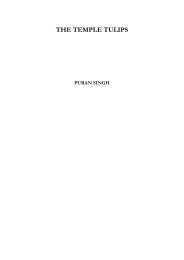
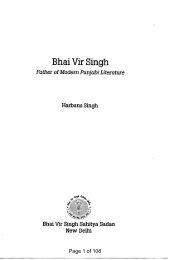

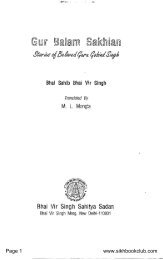
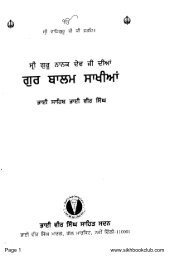
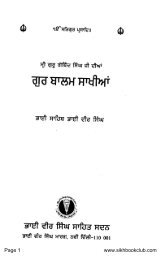
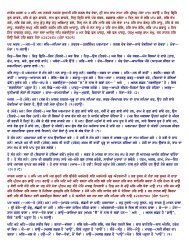
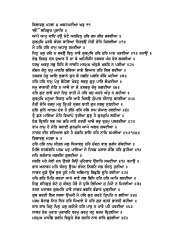

![cOpeI ] hmrI kro hwQ dY r~Cw ] pUrn hoie ic~q kI ie ... - Vidhia.com](https://img.yumpu.com/12240258/1/190x245/copei-hmri-kro-hwq-dy-rcw-purn-hoie-icq-ki-ie-vidhiacom.jpg?quality=85)
